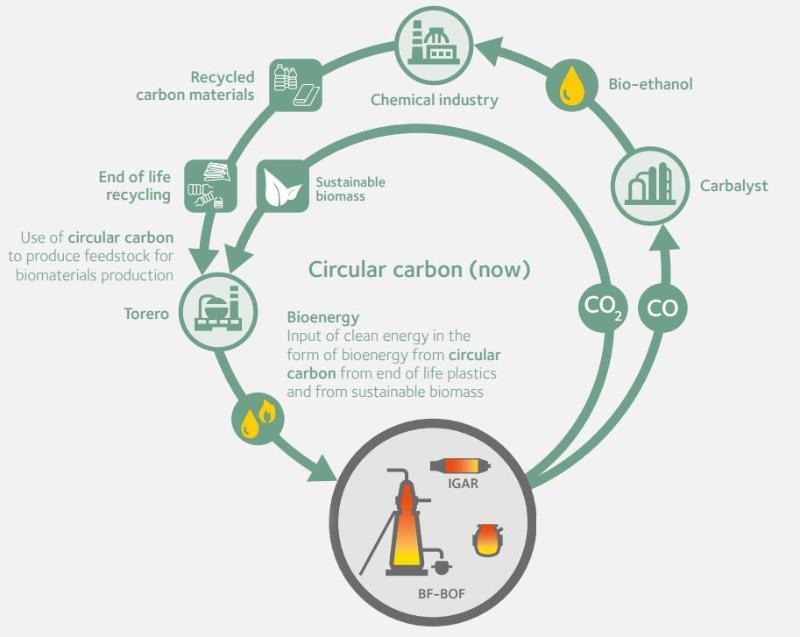Big steelmaker ArcelorMittal uses an innovative steel decarbonisation technology that saves CO2 emissions–and turns them into useful biofuel
Energy-intensive industries cause roughly 15% of worldwide CO2 emissions. The world’s largest steel manufacturer will deploy a pioneering technology to make its production greener and contribute to the circular carbon economy.
A blast furnace uses coal to chemically reduce iron ore into iron, which is then further processed into steel. It releases large amounts of greenhouse gases CO and CO2 in the process. In Europe, steelmakers capture these by-product gases, transforming them into electricity and useful heat. But then the CO2 is released into the atmosphere.
That makes integrated steel plants a key area for decarbonisation. Big steelmaker ArcelorMittal Belgium is implementing a first of its kind, innovative technology at a scale and complexity that doesn’t exist anywhere in the world yet. The project is in line with ArcelorMittal Europe’s carbon emissions reduction roadmap, which targets a 30% reduction by 2030 and carbon neutrality by 2050.
The installation captures the CO- and CO2-rich off-gases emitted from the blast furnace and transforms them into ethanol through a gas fermentation process that uses microbes (Carbalyst® project). This technology was developed by the US firm LanzaTech, with which ArcelorMittal has partnered for a decade.
“As a material producer, we believe that we must focus on circular economy and develop ‘cradle to cradle’ processes which use less primary resources and enable us to reduce the carbon emissions,” says Carl De Maré, ArcelorMittal Group’s head of technology strategy. “Steel and other waste needs to be recycled, and the blast furnace is an excellent tool to do that.”
There’s a second step to the project, too. Since carbon is currently used as an input to the blast furnace in the form of fossil coal, the company intends to partly replace this fossil carbon with waste wood that has been treated to become bio-coal (Torero project). This substitution of fossil coal by a circular carbon is already a step towards the green transition.
“It’s a typical carbon capture and usage process”, De Maré explains. “The blast furnace is in the middle. This project intervenes at the end, at the by-product level, to make ethanol, but also in the beginning, with the torrefaction of carbon from natural sources. By combining both innovations, the output is so-called bio-ethanol: ethanol produced with carbon from biological origin. This closes the carbon circle.”

ArcelorMittal’s Carbalyst® and Torero processes are partially financed by the European Investment Bank
Financing innovation: from theory to practice
This sort of technological innovation is not easy or certain. A substantial investment also needs to be made for the new plants, equipment and machinery. So financing such a venture is a challenge.
Under the European Commission’s InnovFin Energy Demonstration Projects facility, the European Investment Bank signed a loan in May 2020 for €75 million with ArcelorMittal Belgium to partially finance the construction of the new facilities.
“This is an interesting, innovative scheme that’s complex to implement,” says Senso Figaredo Pire, the senior loan officer at the European Investment Bank who closed this complex transaction. “It contributes to the circular economy and generates green ethanol, which can be used as fuel or feedstock in multiple chemical processes.”
“This financing would not be possible without the support brought by the Commission under the InnovFin Energy Demonstration Project programme,” he adds. “We worked closely with the Commission. This project could constitute a significant step forward for the steel industry to make a green transition”.
Implementation will start first at the company’s site in Ghent. This technology aims to use 15% of the by-product gases to produce ethanol, instead of electricity. But Arcelor Mittal’s vision is to replace, progressively and completely, its internal power plants with the transformation of off-gases into ethanol—or, in a future step, into other base chemical products.
The company plans to have five of these plants operating by 2025 across Europe and the rest of the world. The lower amount of power produced by the carbon-containing by-product gases allows ArcelorMittal to move to power-purchase agreements with renewable energy producers, which indirectly supports the development of renewable power.
What’s better than recycled carbon? Recycled and green carbon
The project is economically viable because there is a large demand for ethanol, which is also easier to store and transport than electricity. Ethanol has many different applications. It can be used as fuel, blended with gasoline. It can also be converted into ethylene, a basic component of the plastics manufacturing process, thus contributing to the circular economy.
“This investment protects existing jobs by keeping the steel industry in Europe, where we need highly skilled people to design and operate these plants,” says Marc Tonteling, an engineer at the European Investment Bank.
With the combination of two innovative processes, the company targets the production of 80 million litres of bio ethanol, equivalent to the fuel used by 600 flights between New York and London. ArcelorMittal estimates the CO2 savings to be equal to the yearly emissions of 350 000 cars.
“I liked the enthusiasm and commitment of the people in Ghent, who want to make this project work,” Tonteling says. “We are taking a technological risk, but we want to support the industry, and if this is successful, it can lead to a more generalized production of circular carbon products as bio coal, recycled carbon fuels, bio ethanol and many others.”